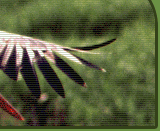Boosting Baltic biodiversity Endangered European species have received a beneficial boost from LIFE project funding for Latvian flood plain management works that resulted in improvements to the favourable conservation status of important EU wildlife and habitats. Europeís floodplains support a rich variety of wildlife species and represent important sources of biodiversity habitat. Wet grasslands, alluvial forests, small and large river channels, permanent and temporary lakes and pools are all common characteristics of flood plain areas. Agriculture and urban land users continue to influence many flood plain habitats and the EUís Water Framework Directive requires Members States to manage their flood plains in a sustainable manner through River Basin Management Plans. This approach helps to prevent the decline of species and sets a long term agenda for conserving flood plain biodiversity in Europe. Flood plains in Latvia are home to protected EU species such as Lesser spotted eagles (Aquila pomarina), Greater spotted eagles (Aquila clanga), Corncrake (Crex crex), Great Snipe (Gallinago media) and Hermit beetle, Osmoderma eremita). This Baltic biodiversity is dependent on Latvian flood plain habitats like Fennoscandian wooded meadows 6530) and Species-rich Nardus grasslands (6230). However, these and other flood plain features have suffered from degradation and LIFE Nature funds were deployed to help restore 15 of the countryís most biologically-important flood plain territories. The LIFE Meadows project opened in October 2004 and ran until June 2008 with an EU budget of around Ä1 145 000. Main objectives focused on restoring key habitats from SPAs and pSCIs in the Natura 2000 network that had not been covered by other management projects. Actions were carried out to reverse damage caused during previous decades, centring on restoration of overgrown areas and involving local farmers in long term management plans for flood plain meadows. Species conservation commitments Outcomes from the project demonstrate the beneficiaryís commitment to conserving European species through the Natura 2000 process. Management plans were first prepared for fourteen Natura sites and these involved collecting data about local wildlife as well as consultation with different flood plain stakeholders. Following development of the management plans the LIFE team began work on restoring 2 244 habitat hectares. Conservation activities here involved clearing scrub and removing excessive vegetation from key sites, including those surrounding oak tree woodlands. Different mowing regimes (manual and mechanical) were then established to maintain desired grassland structures and a network of fences was also introduced to control grazing on the flood plains. All activity was carefully planned to take place outside the nesting season for birds (April to mid July) and a considerable amount of capacity building work was also programmed into each yearís conservation schedule. Results from the public awareness campaign helped to increase understanding among local farmers and communities about the socio-economic and environmental benefits from sustainable flood plain management. Information was provided about different habitat support techniques and knowledge was improved about the opportunities available from agri-environment payments to farmers, since these were identified as effective mechanisms for maintaining the LIFE projectísspecies conservation legacy. Key results achieved by the end of the project included creating a suitable environment for Latvian populations of the Hermit beetle. Species monitoring systems also recorded positive trends in numbers of both Corncrake and Great Snipe. Furthermore, important contributions were achieved in terms of strengthening the favourable conservation status for five habitats (species-rich Nardus grassland on siliceous substrates 6230*, Boreal alluvial meadows 6450, eutrophic tall herb communities 6430, lowland hay meadows 6510 and wooded meadows 6530*). These outcomes demonstrate the LIFE projectís beneficial boost for Baltic biodiversity in Latvian flood plains and some of the most successful outputs are attributed to the teamís ability to involve local farmers in the long term management of the Natura sitesí nature reserves. This is demonstrated by the views of a land owner from Alsunga, J‚nis Gornijs, who says ďInitially I thought that my land in the reserve would only incur economical loss. Now I see the benefits of Natura 2000 and the future possibilities demonstrated by the Floodplain restoration project here. Today, I feel indeed lucky to have the meadows within the UĢava reserveĒ, admits Mr Gornijs. Read more on the project website. Restoration of Latvian floodplains for EU priority species and habitats
LIFE04 NAT/LV/000198 Text from "Animal & plant species: LIFEnews features 2010" 10.03.2010. | 






